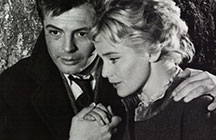|
|
|
|
Le notti bianche
|
 |
|
The story of almost every major Italian director in
the 1950s is their sometimes uneasy negotiation with – and drive to break away
from – the imposing legacy of 1940s neo-realism. Federico Fellini, Michelangelo
Antonioni …
By 1957, Luchino Visconti had already made his
operatic aspirations perfectly clear in Senso (1954), not to mention his work in theatre. But Le notti bianche, an adaptation of Dostoevsky’s oft-filmed tale
“White Nights” – Robert Bresson (Four
Nights of a Dreamer, 1971), James Gray (Two
Lovers, 2008) and Paul Vecchiali (Nuits blanches sur le jetée,
2014) have given us their equally personal, customised takes on its basic plot
template – still managed to throw many critics of the time for a loop.
On the one hand, Visconti had returned to the joys and
sorrows of ordinary people in something resembling everyday life – and he
observed their social context in meticulous detail.
On the other hand, Le
notti bianche flaunted its high degree of artificiality: completely
constructed and filmed on a set, controlling every aspect of weather and
environment for purely expressive and poetic purposes. Unsurprisingly, its
combination of storybook artifice and bittersweet melancholia had a particular
impact on one budding filmmaker soon to launch his debut feature: Jacques Demy.
Of all Visconti’s films, this is the one least
concerned with large questions of European historical and political transition,
of the kind we see so vividly dramatised in The Leopard (1963) or The Damned (1969). Its agony is
intimate, tracing the largely unrequited longing that Mario (Marcello
Mastroianni) feels for Natalia (Maria Schell) – who, while letting herself be
entertained for a few nights by Mario, only pines for her dream-man (Jean
Marais) to return, if he ever will …
As in Jean-Luc Godard’s Vivre sa vie (1962), a dance scene takes prime position in Le notti bianche’s unfolding chronicle. And what a dance scene it is!
As I have argued in my book Mise en scène
and Film Style (Palgrave, 2014), this eleven-minute extravaganza is a set-piece
that sums up what many people mean by classical mise en scène when referring to 1950s work by Vincente Minnelli,
F.W. Murnau or Kenji Mizoguchi.
In the light of his later work, Visconti is often
regarded – inaccurately, in my view – as a director whose method is based on
excess, pure spectacle and proudly superfluous detail. But no touch is
superfluous in Le notti bianche, and
least of all in this central dance scene.
In a club, Mario tries to draw Natalia’s attention, to
make himself irresistible to her through reminiscences and confessions. But as
the dancers hit the floor around them, literally intruding into their personal
space, Natalia is increasingly distracted and Mario realises that his amorous
campaign is lost – unless he gets her out of her seat to join the throng.
Here, too, Mario tries to engineer intimacy – but
Visconti throws every possible obstacle in his way, from the club’s star
show-off dancer (Dirk Sanders) to the changing lights and spaces of the room.
Finally, Natalia flees, once more in search of her
fantasy – and Mario is stuck with the unbearable tension of pathos and defeat.
© Adrian Martin February 2015 |
![]()